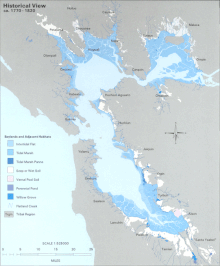Hydrography of the San Francisco Bay Area

The Hydrography of the San Francisco Bay Area is a complex network of watersheds, marshes, rivers, creeks, reservoirs, and bays predominantly draining into the San Francisco Bay and Pacific Ocean.
Bays
The largest bodies of water in the Bay Area are the San Francisco Bay, San Pablo Bay, and Suisun Bay. The San Francisco Bay is one of the largest bays in the world. Many inlets on the edges of the three major bays are designated as bays in their own right, such as Richardson Bay, San Rafael Bay, Grizzly Bay, and San Leandro Bay.
Nearby bays along the Pacific Coast include Bodega Bay, Tomales Bay, Drakes Bay, Bolinas Bay, and Half Moon Bay.
Rivers
The largest rivers are the
In the South Bay, the
Creeks
The Bay Area has a network of
Political groups have been formed to preserve creeks or restore creeks which have been culverted for development.
Springs
The Bay Area has springs which are the source of most of the minor creeks in the East Bay hills such as
Lakes
The Bay Area has many lakes, particularly if one includes artificial ones such as Lake Berryessa. Some are very small (such as Jewel Lake in Berkeley) and others are covered (Summit Reservoir, for example). Lake Merced and Lake Merritt are salt lakes; the former is drying up while the latter is a closed off estuarine cove.
Aquifers
Due to pollution of surface water, much of the area's potable water is located underground, for instance in the Mocho Subbasin of the Livermore Valley. As these aquifers get drawn down by pumping, there is increasing interest in ways to speed up the recharging of these resources.
Wetlands
Prior to the introduction of European agricultural methods, the shores of San Francisco Bay consisted mostly of tidal marshes. Approximately 85% of those marshes have been lost or destroyed, but about 50 marshes and marsh fragments remain.
Wetlands also exist on the Pacific Coast (the
Transportation
The Bay Area is a large natural harbor. Around it have grown seaports and naval facilities. Active ports include the ports of
Many Bay Area cities have marinas, including Berkeley, Petaluma, and Redwood City.
There is also an extensive commuter ferry system, which is being expanded by the
Oceanic harbors have been built at Bodega Bay and Half Moon Bay.
See also
References
- ^ Guide to San Francisco Bay Area Creeks
- ^ "PRBO Conservation Science". Retrieved 2007-12-11.

